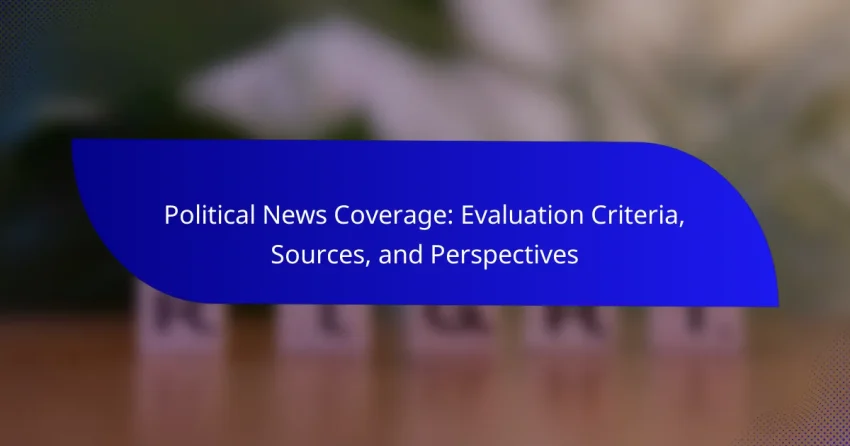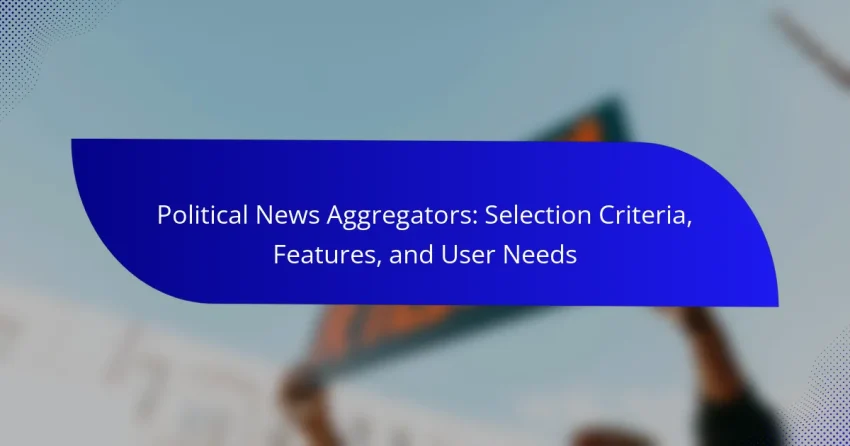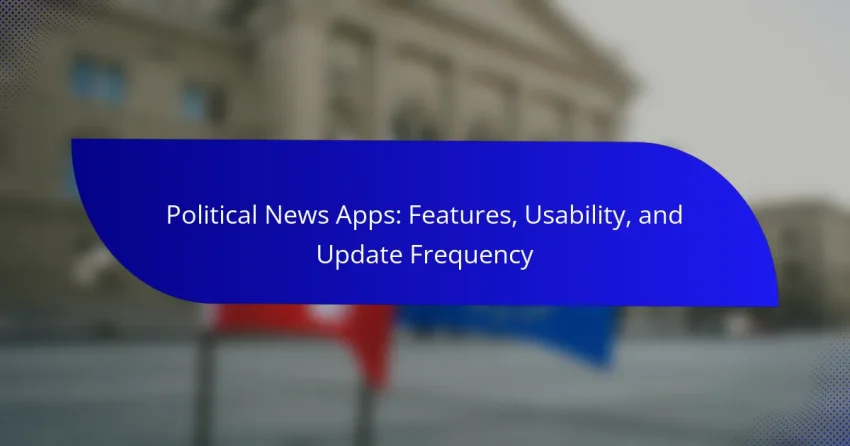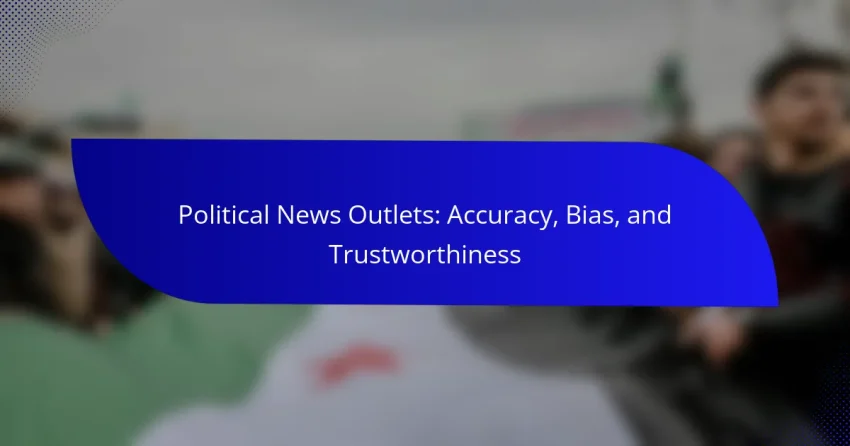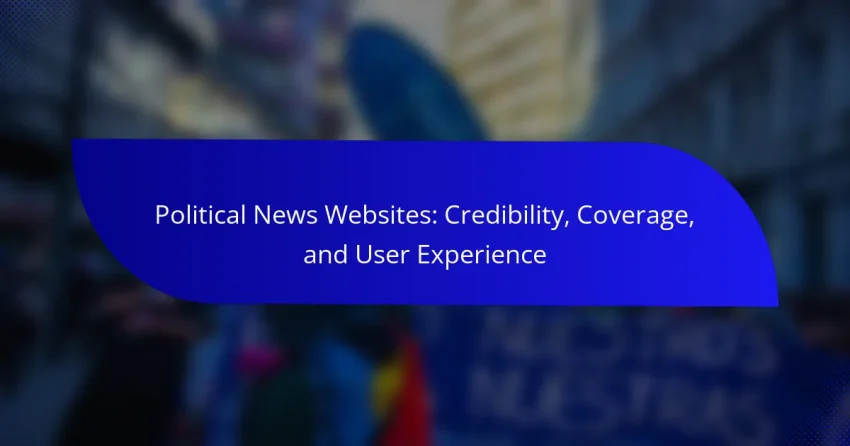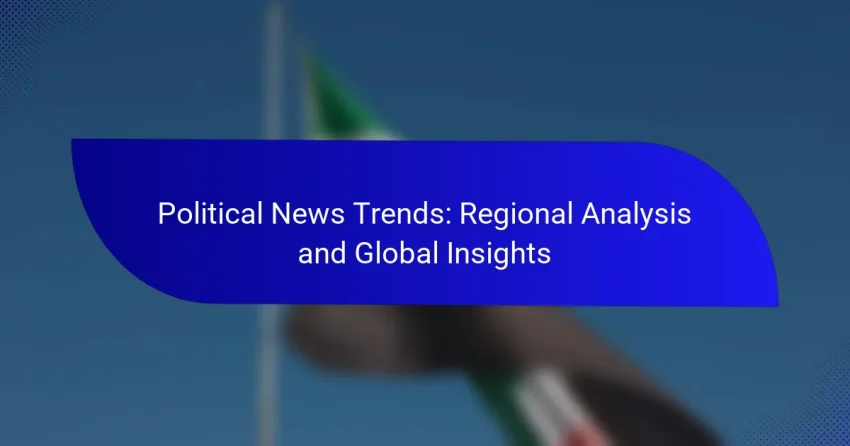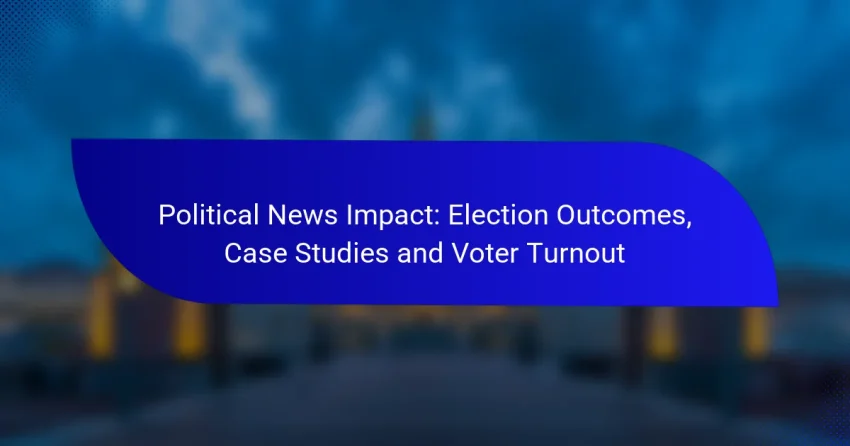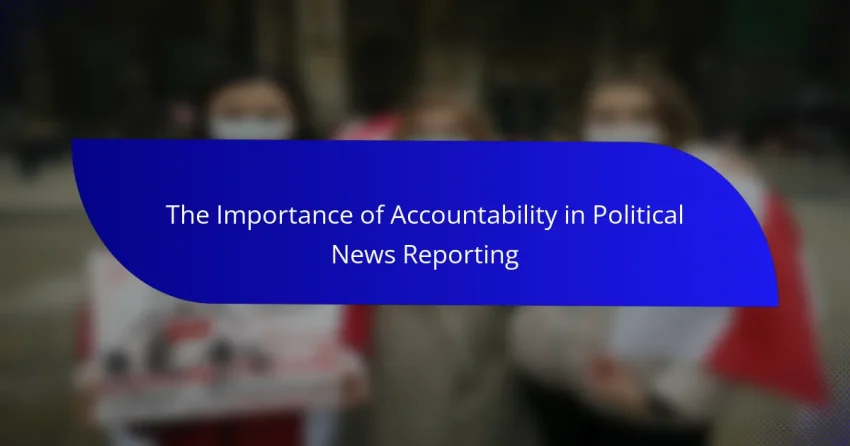Evaluating political news coverage is essential for discerning the reliability and integrity of information. Key criteria such as accuracy, credibility, and bias play a crucial role in helping consumers navigate the complex landscape of political reporting. By understanding these factors and identifying trustworthy sources, individuals can gain a clearer perspective on the political events shaping…
Political news analysis plays a crucial role in understanding the complexities of the current political landscape. By examining key trends such as the influence of social media and the impact of misinformation, analysts provide valuable insights into voter behavior and election dynamics. Utilizing advanced tools and methodologies, they interpret events and their implications, helping both the public and decision-makers navigate the evolving political environment.
Political News Engagement: Strategies, Diversity, and Inclusion
Engaging audiences in political news requires tailored content that resonates and encourages participation. By employing diverse strategies that incorporate a variety of perspectives, news outlets can enhance interaction and ensure that all communities feel represented. Fostering inclusion through collaboration and awareness is essential for comprehensive and impactful political reporting. How to Increase Political News Engagement?…
Political News Aggregators: Selection Criteria, Features, and User Needs
Political news aggregators serve as essential tools for users seeking to stay updated on the latest developments in politics. By curating articles from a variety of sources, these platforms offer personalized content, real-time updates, and a range of perspectives, ensuring users receive relevant information efficiently. When choosing a political news aggregator, it’s important to consider…
Political News Apps: Features, Usability, and Update Frequency
In today’s fast-paced world, political news apps play a crucial role in keeping users informed about current events. These apps not only provide timely updates and a variety of sources but also feature user-friendly interfaces that enhance engagement. With functionalities like real-time updates, personalized news feeds, and offline access, they ensure that users can stay…
Political News Outlets: Accuracy, Bias, and Trustworthiness
In today’s media landscape, the accuracy and trustworthiness of political news outlets are paramount for informed citizenship. Renowned organizations like The New York Times and BBC News uphold journalistic integrity through rigorous fact-checking and source verification. However, inherent biases in reporting can influence audience perception, making it essential for readers to critically assess the news…
Political News Sources: Reliability, Relevance, and Accessibility
In today’s fast-paced information landscape, evaluating the reliability of political news sources is crucial for informed citizenship. Reliable sources are characterized by their commitment to accuracy, transparency, and journalistic integrity, ensuring that they provide unbiased information. By leveraging various platforms, including mobile applications and social media, individuals can enhance their access to trustworthy political news…
Political News Websites: Credibility, Coverage, and User Experience
In today’s fast-paced political landscape, evaluating the credibility of news websites is essential for informed citizenship. Factors such as fact-checking practices, author qualifications, and transparency play a crucial role in determining the reliability of the information presented. Leading political news outlets offer comprehensive coverage and user-friendly experiences, ensuring that audiences receive timely updates and diverse…
Political News Trends: Regional Analysis and Global Insights
The landscape of political news is evolving rapidly across various regions, with distinct trends emerging that reflect local and global dynamics. In North America, a focus on climate policy and the rise of populism are reshaping electoral politics, while Europe grapples with shifting party dynamics and public sentiment. Meanwhile, Asia’s diverse political environments and economic…
Political News Impact: Election Outcomes, Case Studies and Voter Turnout
Political news plays a crucial role in shaping election outcomes by influencing public opinion and voter engagement. Through case studies, we can explore how different news narratives impact voter behavior and turnout, revealing patterns that affect the electoral landscape. Robust news coverage can motivate citizens to participate, while insufficient coverage may lead to disengagement and…
The Importance of Accountability in Political News Reporting
Accountability in political news reporting is vital for maintaining ethical standards and delivering accurate information to the public. By fostering trust between the media and society, it plays a crucial role in supporting a healthy democracy. Journalists and media organizations must implement rigorous fact-checking and transparent reporting practices to uphold this accountability and ensure that…
What Are the Key Trends in Political News Analysis?
Key trends in political news analysis include the increasing reliance on data analytics, the growing influence of social media, a heightened focus on local elections, the pervasive impact of misinformation, and notable shifts in voter demographics. Understanding these trends is essential for comprehending the current political landscape.
Increased use of data analytics
The use of data analytics in political news analysis has surged, allowing analysts to interpret vast amounts of information quickly. This trend enables campaigns and news organizations to tailor their strategies based on voter behavior and preferences.
For example, political analysts now utilize data from surveys, social media interactions, and voting patterns to predict election outcomes. Tools like predictive modeling can help identify key voter segments, making it easier to craft targeted messages.
Rise of social media influence
Social media has become a dominant force in political news analysis, shaping public opinion and influencing voter engagement. Platforms like Twitter, Facebook, and Instagram serve as primary channels for political discourse and information dissemination.
Campaigns now prioritize social media strategies to reach younger voters and engage with constituents in real-time. However, the rapid spread of information can lead to challenges in verifying facts and maintaining credibility.
Focus on local elections
There is an increasing emphasis on local elections within political news analysis, as these races often have a direct impact on communities. Local elections can influence everything from school board decisions to city council policies, making them crucial for residents.
Analysts are paying closer attention to local issues and candidate platforms, recognizing that local elections can serve as a bellwether for broader political trends. This focus allows for a more nuanced understanding of voter priorities at the grassroots level.
Impact of misinformation
Misinformation poses a significant challenge in political news analysis, complicating the landscape for both analysts and voters. The rapid spread of false information can distort public perception and influence electoral outcomes.
To combat misinformation, analysts emphasize the importance of fact-checking and promoting media literacy among voters. Encouraging critical thinking skills can help individuals discern credible sources from unreliable ones.
Shifts in voter demographics
Shifts in voter demographics are reshaping the political landscape, with changes in age, race, and socioeconomic status influencing electoral dynamics. Understanding these shifts is vital for political analysts to accurately assess voter behavior.
For instance, younger voters tend to prioritize issues like climate change and social justice, while older demographics may focus on economic stability and healthcare. Analyzing these trends helps campaigns tailor their messages to resonate with different voter segments.
How Do Political Analysts Interpret Current Events?
Political analysts interpret current events by examining the underlying factors, implications, and broader context of political developments. They utilize various methodologies to provide insights that help the public and decision-makers understand the significance of these events.
Contextual analysis of events
Contextual analysis involves examining the immediate circumstances surrounding an event, including political, social, and economic factors. Analysts consider how these elements influence public perception and governmental response. For instance, a sudden policy change may be analyzed in light of recent public protests or economic downturns.
Analysts often look at the media coverage and public discourse to gauge the prevailing narratives and sentiments. This can help identify potential biases or misinterpretations that may affect public understanding.
Comparative historical analysis
Comparative historical analysis allows analysts to draw parallels between current events and similar occurrences in the past. By identifying patterns and outcomes from previous situations, they can make informed predictions about potential future developments. For example, comparing a current election cycle to past elections can reveal shifts in voter behavior and party dynamics.
This approach often highlights lessons learned from history, helping to avoid repeating mistakes or capitalizing on successful strategies. Analysts may also consider how historical contexts shape current political ideologies and movements.
Expert interviews and commentary
Expert interviews provide valuable insights from individuals with specialized knowledge or experience in political matters. Analysts often seek commentary from political scientists, economists, and seasoned politicians to gain diverse perspectives on current events. This can enrich the analysis by incorporating expert opinions on the implications of specific policies or actions.
Additionally, analysts may summarize key points from these interviews to inform their audience about varying viewpoints. This helps to create a more nuanced understanding of the political landscape and encourages critical thinking among the public.
What Tools Are Used for Political News Analysis?
Political news analysis relies on various tools that help interpret data, gauge public sentiment, and assess voter opinions. Key tools include data visualization platforms, sentiment analysis software, and polling and survey tools, each serving distinct but complementary purposes.
Data visualization platforms
Data visualization platforms transform complex political data into accessible visual formats, making trends and patterns easier to understand. Tools like Tableau and Power BI allow analysts to create interactive dashboards that showcase real-time data, helping stakeholders grasp insights quickly.
When selecting a platform, consider factors such as user-friendliness, integration capabilities with existing data sources, and the ability to customize visualizations. For example, a well-designed dashboard can highlight shifts in public opinion over time, aiding in strategic decision-making.
Sentiment analysis software
Sentiment analysis software evaluates public sentiment by analyzing text data from social media, news articles, and other sources. Tools like Lexalytics and Brandwatch use natural language processing to determine whether sentiments are positive, negative, or neutral, providing a snapshot of public opinion on political issues.
When using sentiment analysis, be aware of potential biases in data sources and the limitations of automated systems. Combining sentiment analysis with qualitative insights can enhance understanding, ensuring a more comprehensive view of public sentiment.
Polling and survey tools
Polling and survey tools gather direct feedback from the public, offering insights into voter preferences and opinions. Platforms like SurveyMonkey and Qualtrics enable researchers to design surveys that can be distributed widely, collecting data on various political topics.
To maximize the effectiveness of polls, ensure questions are clear and unbiased, and consider demographic factors that may influence responses. Regularly conducting polls can help track changes in public opinion, allowing for timely adjustments in political strategies.
How Is Political News Analyzed in the United States?
Political news in the United States is analyzed through various methods that focus on major events, legislative changes, and judicial decisions. Analysts consider the implications of these factors on public opinion, policy-making, and electoral outcomes.
Focus on major political events
Major political events, such as elections, debates, and significant policy announcements, are central to political news analysis. Analysts assess the context, key players, and public reactions to understand the potential impact on future political dynamics.
For instance, during presidential elections, analysts often track polling data, voter turnout, and demographic shifts to gauge candidate viability. This analysis helps predict election outcomes and informs campaign strategies.
Analysis of legislative changes
Legislative changes are scrutinized to determine their implications for governance and public policy. Analysts evaluate new laws, amendments, and proposed bills, considering factors like party support, public opinion, and potential challenges.
For example, when a significant healthcare bill is introduced, analysts might explore its expected effects on insurance coverage and costs, as well as the political ramifications for lawmakers who support or oppose it.
Impact of Supreme Court decisions
The decisions made by the Supreme Court can have profound effects on U.S. law and society. Analysts focus on landmark rulings, interpreting their implications for civil rights, economic policies, and state-federal relations.
For instance, a ruling on abortion rights can reshape state laws and influence public discourse, prompting analysts to assess both immediate and long-term consequences for various stakeholders, including lawmakers and advocacy groups.
What Are the Challenges in Political News Analysis?
Political news analysis faces several challenges that can impact the quality and reliability of insights. Key issues include ensuring data accuracy, recognizing bias in reporting, and adapting to a rapidly changing political landscape.
Data accuracy and reliability
Data accuracy and reliability are crucial for effective political news analysis. Analysts must verify the sources of information, as misinformation can easily spread through social media and other platforms. Cross-referencing multiple reputable sources can help ensure that the data being used is credible.
Additionally, analysts should be aware of the context in which data is presented. For example, statistics can be manipulated to support specific narratives. Understanding the methodology behind data collection is essential for assessing its reliability.
Bias in reporting
Bias in reporting is a significant challenge in political news analysis, as it can skew public perception and understanding. News outlets may have political affiliations that influence their coverage, leading to selective reporting or framing of events. Analysts should critically evaluate the language and tone used in articles to identify potential biases.
To mitigate the effects of bias, analysts can consume news from a diverse range of sources. This approach helps to balance perspectives and provides a more comprehensive view of political events. Tools like media bias charts can also assist in identifying the political leanings of various outlets.
Rapidly changing political landscape
The rapidly changing political landscape poses a challenge for timely and relevant analysis. Events such as elections, policy changes, and international relations can shift public opinion and alter the political context quickly. Analysts need to stay updated with real-time information to provide accurate insights.
Establishing a routine for monitoring news and utilizing alerts for significant developments can help analysts keep pace with changes. Engaging with expert commentary and analysis can also provide deeper insights into the implications of political shifts.
